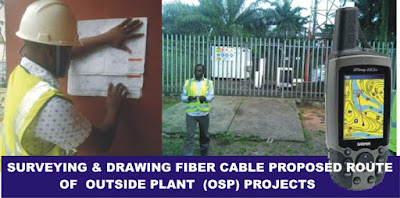CFOS/D: CERTIFIED FIBER OPTICS SPECIALIST
COURSE OVERVIEW
Our mission is to expose our students to the rudiment of fiber optic project from Design to implementation& Documentation.
COURSE OBJECTIVES
• What is involved in designing a fiber optic network?
• How to become a sub-contractor having possessed the skill of writing and defending fiber project proposal
• How to choose components appropriate for communication systems.
• How to proposed routing of the cable plant affects component choice and installation, carrying out fiber route survey using Google earth and GPS
• Using loss budgets to ensure the communications system will work over the fiber optic proposed cable plant
• How to determine what should be tested and documented: interpreting the Sow, preparing the BoQ, quotation and estimates
• What paperwork and documentation will be needed for the project
• How to manage the installation
COMPETENCIES GAINED
• Interpretation of sow
• Fiber proposed route survey
• Preparation of BoQ
• Fiber project implementation skill
• Documentation skill
• Drawing interpretation
• Project management skill
• Software usage (map source, Google earth, excel, Ms-project etc)
• Hardware handling (GPS)
CASE STUDY SCENARIOS
Fiber implementation/application to the various
1. Fibre To The Home
2. Metropolitan Telecom Network
3. Long Distance Telecom Network
4. Corporate LAN Backbone
5. Campus LAN Backbone
6. Industrial Link
7. Date Center
8. CCTV Surveillance Link
9. Metropolitan Government Network
Why Choose IMT COMPUTERS Services
• IMT COMPUTERS Are members of The Fiber Optics Association
• IMT COMPUTERS use Task Based Competence Training
• IMT COMPUTERS issue FOA Certification to Competent Delegate
• Cost and Time Effective for Business
• We also supply Experienced Fiber Optic Technician Nation Wide
• We have trained technician for Major Clients


FIBER OPTICS SPECIALIST COURSE SYLLABUS
Day1 - Day3 schedule
Lesson. 1 Rudiments of fiber optic design
Lesson. 2 Planning the network, route Planning, permission from appropriate authority, rollout, Strategy, handling community issue.
Lesson. 3 Choosing component for project Implementation
Lesson. 4 Reviewing the design, loss budgets Lesson.
Lesson. 5 Writing project specifications, Documents & estimating.
Lesson. 6 Planning and managing project with Hardware and related software.
Lesson. 7 Design case studies
Lesson. 8 Practical application of EXCELL MAPSOURCE and MICROSOFT PROJECT
Lesson. 9 Data acquisition using GPS and Google earth
Lesson. 10 Competencies Assessment Test, Result & Review
Lesson. 11 FOA (fiber optic association) Exam
COURSE GENERAL OVERVIEW
• Copper, Fiber or Wireless?
• Choosing Transmission Equipment
• Planning the Route
• Choossing Components For Premises Installations
• The Link Power Budget • Documentation
• Planning for the install
• Developing A Test Plan
• Planning For Restoration
• Managing the Project
• Planning For Restoration
• Maintaining The Network
• Cabling Standards
Duration: 3DAYS
Training Fee: N150,000
CFOSD Certification Fee : $180
For Class Booking: Complete the REGISTRATION FORM | Conditions: registration can not be confirmed until payment is made in full. |
Call : +234 803 957 6767 | Email : johnson.adejolanew@gmail.com







